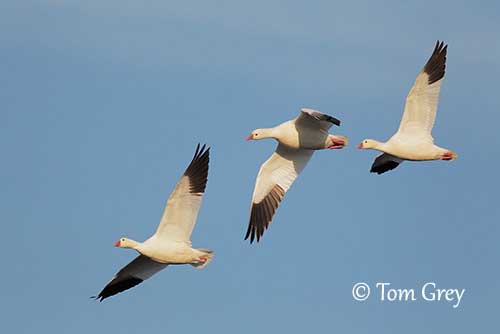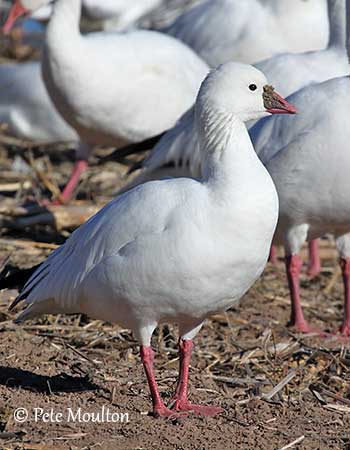
Fr: Oie de Ross
Ang: Ross’s Goose
All: Zwergschneegans
Esp: Ánsar de Ross
Ita: Oca di Ross
Nd: Ross' Gans
Sd: Dvärgsnögås
Photographers:
Tom Grey
Tom Grey's Bird Pictures
Tom Merigan
Tom Merigan’s Photo Galleries
Pete Moulton
Pete Moulton Photography
Texte de Nicole Bouglouan
Sources:
HANDBOOK OF THE BIRDS OF THE WORLD vol 1 by Josep del Hoyo-Andrew Elliot-Jordi Sargatal - Lynx Edicions - ISBN: 8487334105
FIELD GUIDE TO THE BIRDS OF NORTH AMERICA - National Geographic Society - ISBN: 0792274512
GUIDE DES CANARDS, DES OIES ET DES CYGNES – de Steve Madge - Delachaux et Niestlé - ISBN: 2603013769
All About Birds (Cornell Lab of Ornithology)
Bird Web (Seattle Audubon Society)
What Bird-The ultimate Bird Guide (Mitchell Waite)
Wikipedia, the free encyclopaedia
WWT – Wildfowl
A preliminary study of the breeding biology of Ross’s Goose
By JOHN P. RYDER (University of Alberta, Edmonton, Alberta; Canadian Wildlife Service, Edmonton, Alberta)
A possible factor in the evolution of clutch size in Ross’ Goose By JOHN P. RYDER
Ross's Goose, Chen rossii, and hybrids, in New York
Ross’s Goose
Chen rossii
Anseriformes Order – Anatidae Family
INTRODUCTION:
It is always difficult to separate Ross’s Goose and Snow Goose, but some morphological features allow to find the difference.
The Ross’s Goose was recognized as a different bird in 1770, and was described for the first time in 1861, and its arctic breeding grounds were discovered only in 1938. This species breeds in N Canada and winters in S USA and New Mexico.
The Ross’s Goose is now placed in the genus Chen with the Snow Goose and the Emperor Goose, named the “white geese” but it was formerly in the traditional genus “Anser” that includes the “grey geese”.
The population is significantly increasing and this species is currently not threatened.

DESCRIPTION OF THE BIRD:
Biometrics:
Length: 53-66 cm
Weight: M: 1225-1880 g – F: 1270-1660 g
Compared to the Snow Goose, the Ross’s Goose is smaller, with shorter neck and rounder head (generally lacking the rusty stains), and shorter pink bill with bluish-grey warty growths at base.
The Ross’s Goose adult male has all-white plumage except the black wingtips and the greyish primary coverts. We can see several conspicuous furrows on neck sides and hindneck.
The stubby, triangular bill is pinkish-red with warty bluish-grey protuberances at base, visible at close range. These ornaments are more conspicuous in males and older birds. The eyes are dark brown. Legs and webbed feet are pinkish.
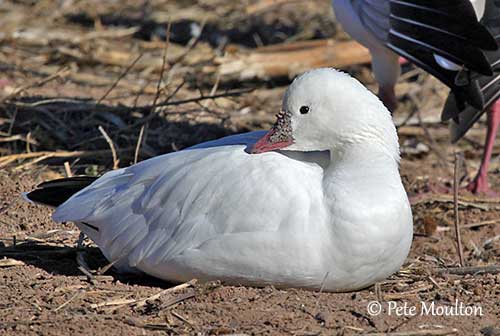
The female has similar plumage but she is smaller overall. She has shorter neck, slightly flatter forehead, less conspicuous furrows on neck, and reduced warty protuberances at base of bill.
The juvenile may have a pale grey wash on head, back and flanks, but it is much paler than the juvenile Snow Goose.
There is a very rare blue morph, fairly similar to dark Snow Goose, but it has less white on head and neck, and more white on the underparts. This blue morph was confirmed in 1971.
RANGE:
The Ross’s Goose breeds in Arctic Canada in Queen Maud Gulf, Baffin Island, Southampton Island and the W coasts of Hudson Bay. It is rare on Banks Island and in Alaska.
It winters in S USA, in California E to Louisiana, New Mexico, Texas and NC highlands of Mexico.
HABITAT:
The Ross’s Goose breeds on lake islands on the high Arctic tundra, in marshes, ponds and grain fields. It frequents mainly the flat areas of the tundra, with mixed grassy areas and low thickets of dwarf birch or willow.
During the migration, it can be seen in grasslands and grain fields in E Great Plains and Mississippi Valley. During winter, it frequents shallow lakes, freshwater marshes, flooded fields and cultivated areas. They roost in flocks at lakes and reservoirs.
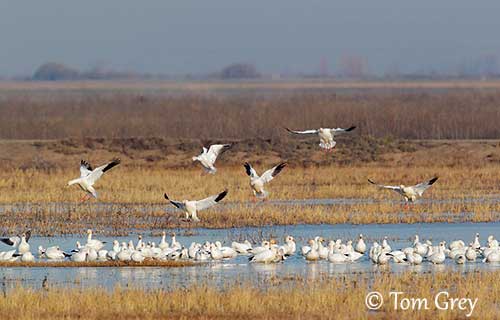
CALLS AND SONGS: SOUNDS BY XENO-CANTO
The Ross’s Goose gives higher pitched calls than the Snow Goose. It utters a short growl in flight “konk” and a weak cackle “kek-ke-gah”.
They communicate by sad, whispered “uuuhhhh”. The call is loud, a repeated “uuggh uuggh uuggh” often higher pitched in female.
Calling often increases during the displays, or when the birds are threatened.
BEHAVIOUR IN THE WILD:
The Ross’s Goose feeds primarily on plant material, usually sedges and green grasses. At the beginning of the breeding season, it feeds on roots before the new growth. During the autumn migration, it takes mostly seeds and grains, both of wild grasses and cultivated crops.
The Ross’s Goose feeds in flocks often with Snow Geese during migration and winter. It forages by wading and swimming in shallow water, taking the green parts of numerous aquatic plants, but also by walking on land, searching for roots, leaves, seeds and grasses.
The pairs are usually formed at arrival on the breeding grounds. During the courtship, both mates perform rapid head-dipping. As soon as they arrive on the nesting sites, they establish the territory and the female starts to build the nest.
Some aggressive behaviour against neighbours is reported. The owner holds the neck horizontally with wide open mouth towards the intruder, and following the charge, it returns to its mate. Both mates defend the territory with the same threat display, accompanied by a high-pitched squawk by both adults, and a low moaning growl prior and after the attack. Physical contact may occur during serious conflicts. The low moaning sound is given by the owner of the territory, while it is coming back to its mate, with the neck stretched upwards. The intruders usually show very little resistance and often run away or take-off immediately.
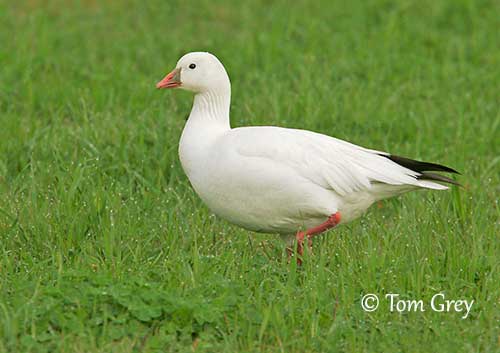
The Ross’s Goose is migratory. They migrate from the Northwest Territories in N Canada to Central California, following a narrow route with stopovers in Alberta and Montana. They migrate in flocks, often with Snow Geese and other geese.
This species is vagrant elsewhere in N America, and probably too in NW Europe in Greenland, Faeroes, Iceland, British Islands, and some records in Belgium, Denmark, Estonia, Germany and the Netherlands, Norway and Sweden. Some adults are recorded sometimes in E Palearctic on Wrangel Island and in Barents Sea.
The Ross’s Goose has rapid, direct flight with powerful, fast wingbeats.
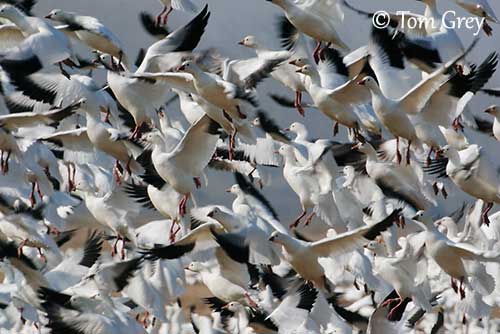
REPRODUCTION OF THIS SPECIES:
The breeding season starts in late May/June. The Ross’s Goose is usually monogamous with long-term pair-bonds, but some extra-pair copulations are sometimes recorded.
These geese breed in colonies often associated with Snow Goose colonies. The nest-site is established on islands or on the shore of a lake in the tundra, often at the edge of low thickets of dwarf tree species. The nest-site can be reused for more than one season.
The female builds the nest on the ground, a bulky bowl made with twigs, leaves, grasses and moss, and typically lined with down. She may continue the building after starting the incubation.
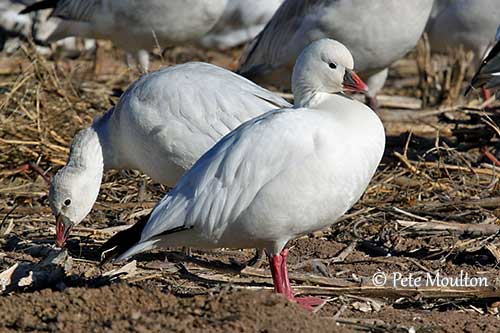
Juvenile on the left
Female on the right
She lays 2-6, rarely 1-8 dull white eggs that become stained through the incubation period. She incubates alone during 21-23 days, and she is guarded by the male during this period. The chicks are precocial and leave the nest very soon after hatching, usually within 24 hours. They are able to swim and to feed, but they are tended by both parents. They fledge 40-45 days after hatching and remain in family groups until the next season. The male does most of nest defence against predators such as gulls and arctic fox.
The Ross’s Goose hybridizes with the Snow Goose and produces fertile hybrids.
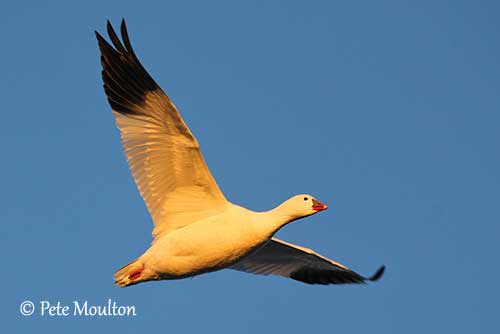
Comment by the photographer:
It looks like a perfectly good Ross', and that's what I thought it was when it flew past me, but the white feathering at the base of the bill is convex, and the black along the cutting edge of the bill is more extensive than is usual for Ross', though some of that may be shadow. The convexity and black cutting edge are standard features in Snow Geese, where they're even more pronounced. This one falls in between the extremes.
PROTECTION / THREATS / STATUS:
The population of the Ross’s Goose has significantly increased in recent decades, in spite of legal hunting in some parts of the wintering range. This population was estimated to number 1,050,000 individuals in 2002.
The wintering grounds are very limited, making this species vulnerable to diseases and natural events.
But currently, the Ross’s Goose is evaluated as least Concern.
